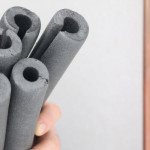Keep Your Plumbing Break-Free This Fall and Winter
Winter weather sneaks up yearly, ready to pounce on unprotected plumbing, costing homeowners a pretty penny in pipe repairs. Taking time before temperatures drop below freezing keeps pipes functional, preventing bursts and secondary issues due to water damage. Protecting plumbing in the winter is easier than some may think.
In this article, plumbing experts share tasks that are either free or low-cost (and cheaper than pipe repairs) and can be done without professional help.
Insulate All Outdoor and Exposed Pipes
 Insulating pipes exposed to the air, inside and outside the home, decreases their risk of freezing or bursting. These often include pipes in spaces like:
Insulating pipes exposed to the air, inside and outside the home, decreases their risk of freezing or bursting. These often include pipes in spaces like:
- Attics
- Crawl spaces
- Unfinished basements
- Garages
Pipe insulation comes in many different sizes and materials, providing the best protection against freezing pipes. Fiberglass or polyethylene tubular pipe sticks are easy to measure and fit to exposed plumbing, and the materials are designed to offer optimal protection with as little bulk as possible.
Homeowners can even insulate pipes using towels, rags, pool noodles, or newspapers in a pinch. Remember that while these methods protect against freezing pipes, they come with their own risks of flammability, lower efficiency, and a bigger headache to clean up if they fail.
Keep the Heat on and Cabinets Open to Protect Interior Pipes
 Heating a room is only helpful if the warmth can work into every nook and cranny, and closed cabinets may prevent this. When temperatures drop to freezing levels, cabinet doors under sinks and in other areas and housing plumbing should be open so the warm air can combat frozen pipes.
Heating a room is only helpful if the warmth can work into every nook and cranny, and closed cabinets may prevent this. When temperatures drop to freezing levels, cabinet doors under sinks and in other areas and housing plumbing should be open so the warm air can combat frozen pipes.
Keeping the heat on and cabinets open, even in the guest bathroom that no one uses, reduces the risk of a pipe burst, which can cause immense damage. Consider opening the cabinet doors and setting up a space heater for a more economical solution.
Ensure everyone knows to keep the heat on and cabinets open.
Don’t Forget to Disconnect Hoses From Outdoor Faucets
Frozen pipes are often found in the exterior lines of a home because they’re less insulated and more challenging to manage. Even disconnecting hoses from outdoor faucets can be the difference between a burst pipe and an intact one.
Once the hose is disconnected, drain the excess water and store it in a shed or garage to protect against cold damage.
Styrofoam faucet covers help trap heat from inside the home around the outdoor spigot, protecting it from freezing or cold-related damage to the valves and seals. If possible, shut off the water supply to the outdoor faucet and open it so any remaining water drains from the pipes.
About Laney’s Inc.
With over 60 years of service in the Fargo-Moorhead area, Laney’s Inc. has proven its plumbing and HVAC expertise. They know emergencies don’t stick to work hours and offer competitive around-the-clock rates without overtime charges and free second opinions. For a quick response with a family-owned feel, contact Laney’s Inc. for your plumbing needs in the Fargo region today!













